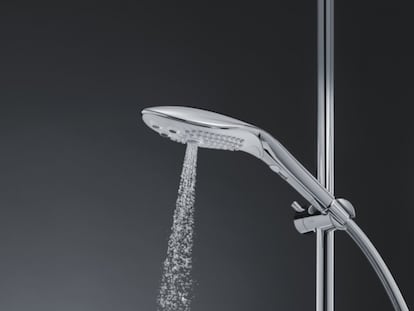Men and the fear of being replaced by the Satisfyer
Will sex toys replace men when it comes to female pleasure? A change of perspective is necessary

Female desire came out of the closet in 2019, when a clitoris suction toy called the Satisfyer became a social phenomenon and the star product of that Christmas. It not only contributed to destroying taboos about female masturbation, but also to reduce the so-called orgasm gap: men having more orgasms than women. Sexologist Megwyn White, Satisfyer’s education director, says that “sex toys help shared intimacy to be a pleasurable experience for everyone involved. They become tools for a game that liberate desires, expand boundaries and start a shared adventure of passion and exploration.”
However, sexologists around the world started to notice a consequence: accustomed to the product’s efficiency and speed, women could no longer reach orgasm without it. “As time passed, I had to stop using it, because I was incapable of orgasming without it, especially with a partner,” says Sara M., a 42-year-old publicist. Cristina Callao, a psychologist and sexologist, warns that we should not ignore the inconvenient features of these products. “We have turned masturbation in an infallible speedway with a single purpose: the immediate orgasm. The brain establishes synaptic connections and learns things, like a concrete path to reach a place. If I use the suction toy repeatedly, without diversifying, always in the same way and at the same speed, it is likely that when I try to masturbate with my hand, or interact with someone else, I will feel frustrated and unsatisfied about not being able to orgasm.”
However, Megwyn White argues that the belief that the use of a Satisfyer, or other sex toy, can make it impossible to reach orgasm alone is a myth. “It’s true that its use can increase the intensity of orgasms during solo play, but it is essential to recognize that orgasms originate inside of us and form part of a subjective personal experience, which comes from our own physical and emotional responses to pleasure,” she explains.
Clitoris suction toys have already been featured on television. In the new season of the Netflix show Valeria, one of the protagonists uses the Satisfyer so much that viewers may expect it to appear in the final credits. In 1998, Sex in the City turned the Rabbit vibrator into a pop culture sensation, as part of a new wave of consumption of sex toys.
What can men do?
Satisfyer Men One was released as a male alternative for those who felt jealous of women’s’ newly intense orgasms. But what many feared was not lacking their own sex toy, but that women no longer needed them in bed.
Megwyn White argues that men’s’ sense of intimidation by sex toys is due to the mistaken idea that they are tools designed to solve problems: that women use them because of problems in their sex life. “Men deserve to know that their value in the realm of intimacy goes far beyond performance, and shedding that pressure can lead to liberation. By embracing play and incorporating sex toys, men can discover an erotic world that transcends traditional expectations. That being said, the deeply ingrained social programming around masculinity and intimacy requires constant reminders and opportunities for men to embrace a new narrative,” she says.
Author and sexologist Laura Cámara believes that the rejection that some feel towards the suction toy is due to the centering of male sexuality in heterosexual couples. “When we introduce the suction toy, it may seem to them that the toy replaces them, fulfilling a mission that they previously fulfilled, which is why fears and complexes appear. That is why it is so important to deconstruct this idea of male sexuality and heterosexual sex, because everyone is responsible for their own pleasure, and it can be enjoyed as a couple using toys,” she explains. “Male sexuality is fragile in this sense. If men feel like something is competing with them, they are scared. Female sexuality is more autonomous and has long since broken with the myth that it is the man who has to lead her to pleasure and guide her to orgasm.”
A survey of 500 British men revealed that 60% of men suffer from anxiety about their performance in bed, highlighting the pervasive impact of these societal pressures. Men who interpret their partners’ use of sex toys as a sign that they are inadequate or unable to meet their needs and desires are met with feelings of insecurity and a sense of being out of step with their partner’s pleasure.
Benjo Podlech Sandoval, psychologist and masculine energy expert, clarifies that if in heterosexual relationships the relationship with man’s pleasure is phallocentric, sexuality and pleasure are reduced. “If some men feel rejection or fear of the Satisfyer, you have to welcome those emotions, accept them and give them their place. The first thing is to try to accept his fears and feelings in order to change them, in this case that thought of ‘if she enjoys the Satisfyer, she doesn’t need me.’ Then, they have to understand that tastes are infinite and change over time, so talking about a sex toy could be as simple as talking about breakfast. After that openness and communication, you could experiment with the Satisfyer again and see if the perception changes. He might even be glad that his partner experiences different pleasures with him, and he can enjoy the creativity that toys can bring if used together.”
The industry shares Sandoval’s perspective: clitoral suction devices can be used by couples. There are models created specifically for joint use. But much more difficult than using them is the conversation about introducing them into the relationship. “It’s important to communicate that the introduction of a sex toy is not a substitute for your partner’s role, but rather an opportunity to explore new experiences together,” White says. “One effective method is to frame the request between two positive statements: ‘I love making love and I value the connection we share, and I’m curious about incorporating a vibrator into our intimate moments.’ By expressing your appreciation for the current state of your sex life and emphasizing your desire to improve it, you highlight the strength of your bond while introducing the idea of incorporating a sex toy.”
“I think that the more options there are to enjoy as a couple, the better!” says Xavi T., 42, a product manager. “In the end, the sex toy complements the experience, both solo and together.” The psychologist and sexologist Cristina Callao concurs: “Sex toys, specifically the suction toy, have highlighted that women do not need to insert anything into our vagina to experience pleasure, something that, apparently, has not been good for some men. I think that those who are afraid of being replaced by a toy should take note and learn that there is an area in the body of women called the clitoris that has been invisible for years. Instead of feeling afraid, just keep it in mind in your next sexual encounters.”
Sign up for our weekly newsletter to get more English-language news coverage from EL PAÍS USA Edition
Tu suscripción se está usando en otro dispositivo
¿Quieres añadir otro usuario a tu suscripción?
Si continúas leyendo en este dispositivo, no se podrá leer en el otro.
FlechaTu suscripción se está usando en otro dispositivo y solo puedes acceder a EL PAÍS desde un dispositivo a la vez.
Si quieres compartir tu cuenta, cambia tu suscripción a la modalidad Premium, así podrás añadir otro usuario. Cada uno accederá con su propia cuenta de email, lo que os permitirá personalizar vuestra experiencia en EL PAÍS.
¿Tienes una suscripción de empresa? Accede aquí para contratar más cuentas.
En el caso de no saber quién está usando tu cuenta, te recomendamos cambiar tu contraseña aquí.
Si decides continuar compartiendo tu cuenta, este mensaje se mostrará en tu dispositivo y en el de la otra persona que está usando tu cuenta de forma indefinida, afectando a tu experiencia de lectura. Puedes consultar aquí los términos y condiciones de la suscripción digital.
More information
Archived In
Últimas noticias
Most viewed
- Oona Chaplin: ‘I told James Cameron that I was living in a treehouse and starting a permaculture project with a friend’
- Reinhard Genzel, Nobel laureate in physics: ‘One-minute videos will never give you the truth’
- Sinaloa Cartel war is taking its toll on Los Chapitos
- Why the price of coffee has skyrocketed: from Brazilian plantations to specialty coffee houses
- Silver prices are going crazy: This is what’s fueling the rally










































